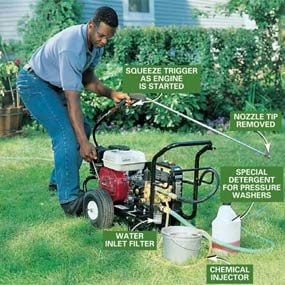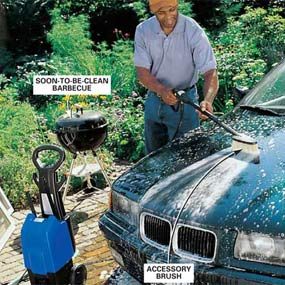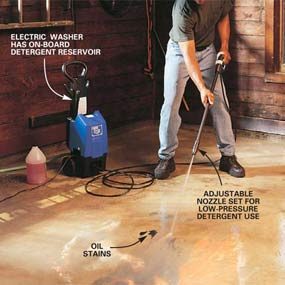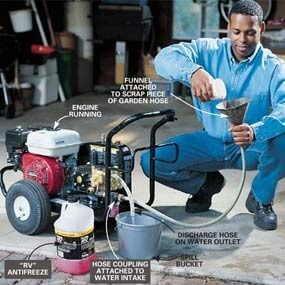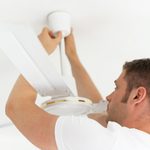How to Use a Pressure Washer
Updated: Oct. 02, 2018Wash siding, concrete floors, decks and even your car faster and easier.
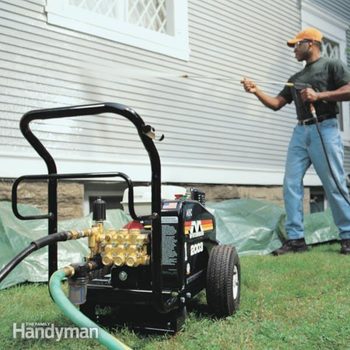
Two types of pressure washers and how they work
Pressure washers (aka power washers) are so much fun to use—and show such dramatic and quick results—that you’ll be begging to clean your neighbors’ siding, driveways and cars once you’ve finished your own. You can rent or buy a pressure washer to clean nearly any outdoor item. By following the pressure washer tips in this article, you’ll learn how to use pressure washers safely and efficiently.
Pressure washers, whether they’re powered by electric motors or gas engines, run a pump that pressurizes the water from your garden hose to 1,000 lbs. or more, then forces it out through a spray wand. The higher the pressure (measured in pounds per square inch—psi), the tougher the cleaning jobs they can tackle. Both types require a steady, uninterrupted supply of water (in gallons per minute—gpm). For occasional use, most homeowners will find that a washer with a pressure range of 1,300 to 2,400 psi works best.
Electric pressure washers deliver 1,300 to 1,400 psi, require about 1-1/2 gpm and are the best choice for light-duty cleaning like washing cars (Photo 3), outdoor grills and garage floors (Photo 4). They generally cost less and are quieter, lighter in weight and more portable than gas-powered washers. Many have built-in tanks for optional detergent use. Always connect electric washers to power outlets that are protected by a ground fault circuit interrupter (GFCI) and use only 12- or 14-gauge extension cords.
Most pressure washers that you’ll find for rent or sale are gas-powered. This type can deliver higher water pressure than the electric kind, some more than 3,000 psi. But gas-powered washers also require more water: 2 to 3 gpm. These washers are the best choice for bigger jobs like preparing siding for painting (Photo 2), removing “aging” stains from wood decks (Photo 5) and deep-cleaning concrete. You can rent one at tool rental stores, along with accessories like chemical injectors (Photo 1) or longer spray wands for reaching high places. Gas-powered washers (non-commercial units) cost $300 to $800 depending on the pressure they deliver, their features and the engine and pump quality.
Spray Nozzles for Different Tasks
Pressure washers that deliver less than 2,400 psi generally come with a single adjustable spray nozzle that delivers zero to 60-degree fan patterns. Some brands offer accessory “rotating” or “turbo” nozzles that clean more effectively than standard adjustable nozzles because they spin the water stream.
Heavier-duty units generally come with four or five color-coded, individual nozzle tips (three are shown here). They create specific fan patterns: wider (for using detergents), medium (for general cleaning) and narrower (for blasting deep stains).
Insert individual nozzle tips into the spray wand by retracting the quick-coupling collar, pushing the tip in as far as it will go and releasing the collar. Pull on the tip to confirm that it’s firmly locked in position. Point the spray wand away from people and property when starting the power washer.
Pressure Washer Tips: Operating procedures
All pressure washers seem intimidating the first time you use them. Have the rental center or tool retailer instruct you on its use, and follow these pressure washer tips and guidelines:
Water supply
Make sure your water supply can deliver the gallons per minute specified for your machine. For example, if your pressure washer needs 2-1/2 gpm, time how long it takes your garden hose to fill a 5-gallon pail. The garden hose must be 50 ft. long or less and have a 3/4-in. inside diameter, with standard 3/4-in. hose fittings for connecting to the washer’s inlet. To ensure that water circulates unobstructed through the system, check the water inlet filter or screen and clean it of debris. Also, make sure the garden and pressure hoses are kink free.
Start-up procedure (Photo 1)
Before starting the washer, it’s imperative that water is flowing through the washer and out the spray wand. Follow these steps:
-
- Tighten all hose connections so no air can enter the lines.
- Set the spray wand to a low- or no-pressure setting to prevent recoil, or kickback, when the washer is started. Electric washers and gas washers with variable nozzles should be on low-pressure, wide fan settings. Gas washers with individual nozzle tips should have their nozzle tip removed at this point.
- Completely turn on the water faucet at the house. Squeeze the spray wand trigger to prime the pump and purge air from the system.
- Start the washer (Photo 1). If it’s a gas unit, steady it when pulling the starter cord by bracing your foot against a wheel. Let the washer run for a minute to warm up. To avoid damaging the pump: Never run a washer longer than three to five minutes (depending on the model) while the trigger is off.
- With the washer running and the trigger locked “off,” adjust pressure and spray settings, or insert nozzle tips in the spray wand. Now the washer is ready to use.
Power cleaning techniques
Pressure washing removes dirt and grime, but it isn’t designed to strip paint or kill mildew on siding or decks. For the best cleaning results without damaging any surfaces, first, test the pressure setting and spray pattern on an inconspicuous place. When washing house siding, follow these rules:
-
-
-
- Lay tarps around the house perimeter to protect plants and collect paint chips blown off during washing. Houses built before 1977 may have lead paint chips that will have to be collected and properly disposed of at a hazardous waste facility.
- Don’t hold the spray wand “head on” to the siding. This drives dirt into the surface rather than washing it away. Hold the wand at a 45-degree angle to the siding and at a distance that yields the best cleaning results without gouging wood or denting metal or vinyl.
- Work small areas at a time. To prevent streaks, start washing from the bottom and work up. For even cleaning, use long, overlapping strokes. Rinse the siding by working from the top down.
- Avoid driving water up behind the siding by keeping the spray stream level. Use an extension spray wand for reaching higher places. Be careful when using a lance extension. The “kickback” can throw it into contact with power lines.
- Don’t spray windows. The high pressure can break them.
-
-
Better cleaning with detergents
Detergents and accessory brushes increase cleaning effectiveness while reducing cleaning time. When renting or buying a pressure washer, inquire what accessories and detergents are available for it. To prevent damage to the internal parts, never run bleach in the machine or use detergents not designated for use in pressure washers.
Detergents can only be run through pressure washers using a wide spray pattern. In addition, electric power washers require a low-pressure setting on the spray wand. Follow your machine’s instructions for using detergents, diluting the detergent and (if necessary) hooking up a chemical injector (Photo 1).
For the best cleaning results, first, loosen the dirt with plain water under high pressure using a medium spray pattern. Next, apply the detergent using a wide nozzle setting and let the detergent sit a few minutes to penetrate the dirt. Keep the surface wet to avoid possible discoloration or damage by the detergent. Finish by resetting the nozzle to a medium pattern (or changing the nozzle) and rinsing with plain water. Switch detergents by draining the first detergent from the pressure washer, rinsing the system with plain water and introducing the next detergent.
CAUTION!
Pressure washers deliver extreme pressure and can cause serious injuries if misused. For safety, follow these guidelines:
- Don’t point the pressure washer at people or pets or put your hand in front of the nozzle. The pressurized water stream could actually penetrate your skin or cause serious cuts.
- Wear safety glasses when operating the washer.
- Don’t use pressure washers while working from ladders. Once you squeeze the trigger, the powerful recoil on the spray wand can throw you off balance and off the ladder.
- Maintain a minimum 6-ft. distance when spraying water around power lines, electrical masts or outlets.
- Before uncoupling hoses, stop the machine, turn the water faucet off and squeeze the spray wand trigger to release all water pressure in the system.
- Engage the safety lock on the trigger when you’re not actually washing and when changing nozzle tips.
Maintaining the machine
If possible, store the power washer indoors in the off-season to avoid damage to the pump, hoses and spray wand. Otherwise, winterize them using only antifreeze designed for recreational vehicles (RVs); see Photo 6. When a gas-powered washer won’t be used for a month or more, prevent damage to the engine by draining the system of gas or adding a gas preservative to the fuel tank.
Required Tools for this Project
Have the necessary tools for this DIY project lined up before you start—you’ll save time and frustration.
- Rags
- Safety glasses
Required Materials for this Project
Avoid last-minute shopping trips by having all your materials ready ahead of time. Here’s a list.
- Special detergent for pressure washers
